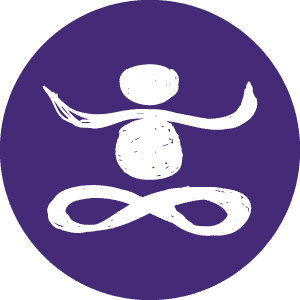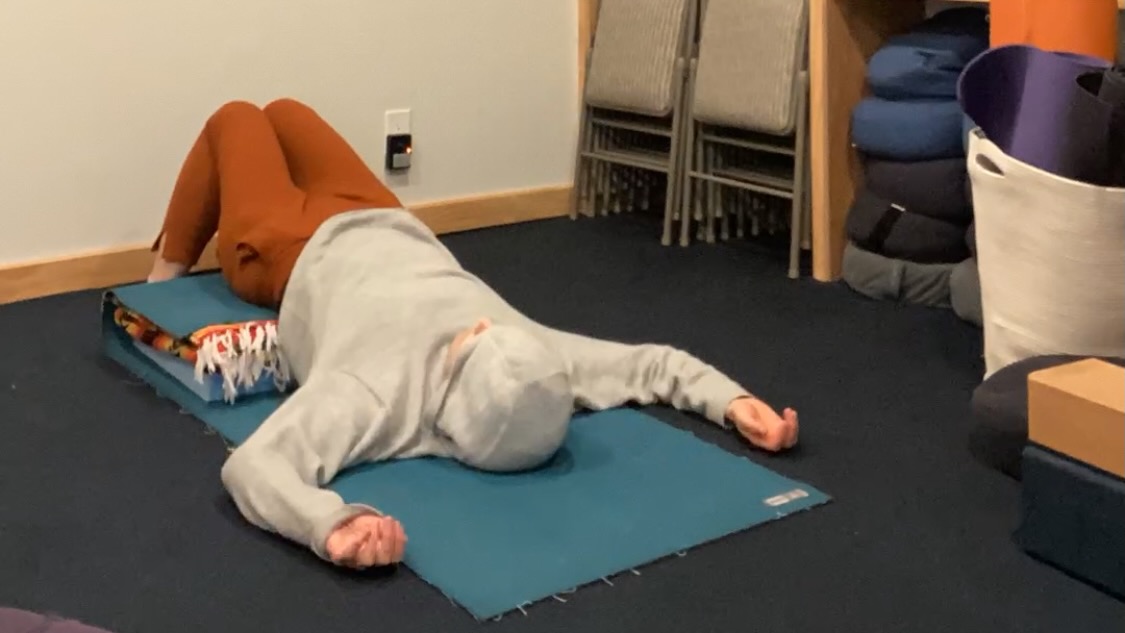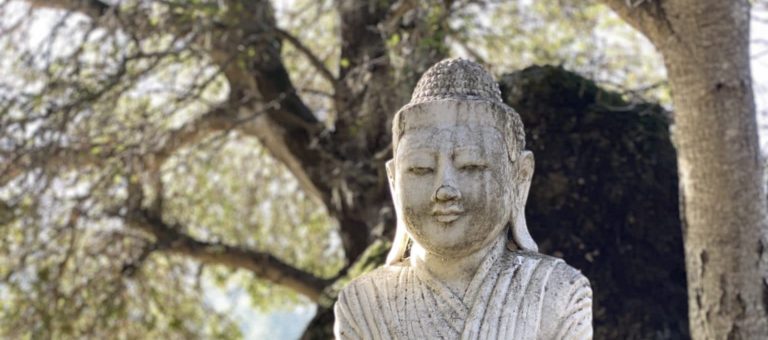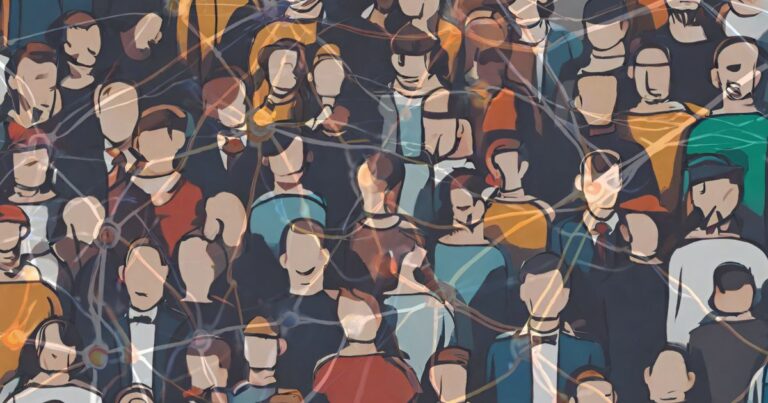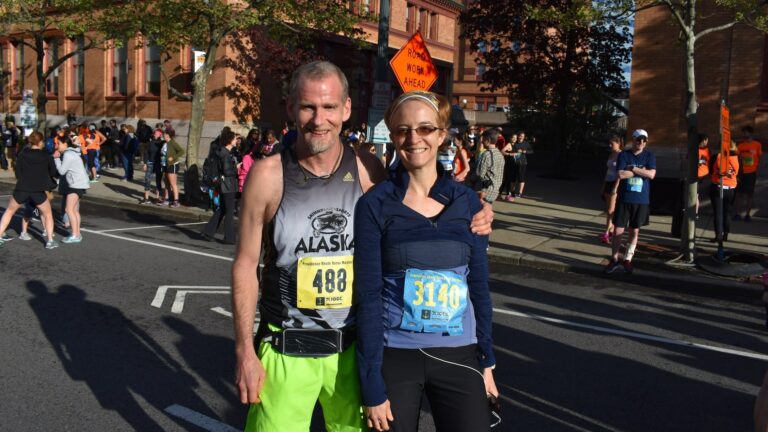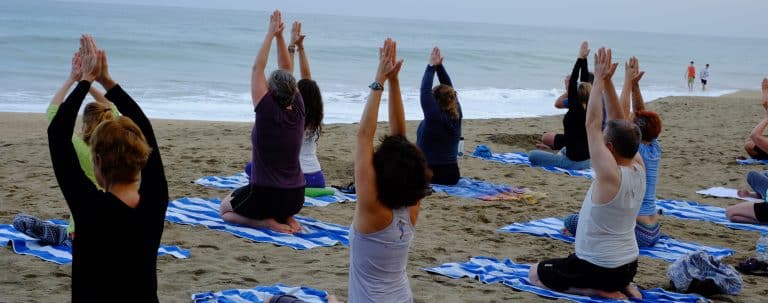The origins of yoga are found, at least in written form, in Hindu texts that are thousands of years old. There it is referred to as “skillful action.” There are also numerous depictions of postures that we still practice today in stone reliefs, textiles, and art of the era.
I was taught that the full canon of postures developed for two reasons. The first was to make the classic seated meditation posture accessible. You know if you’ve every tried it… discomfort in the body is neck in neck with discomfort in the mind/heart in the race to be the biggest obstacle to practice. Nowadays, we use all kinds of props to support our postures but in more austere times, those things just weren’t available. It was the body itself that needed to hold steady, alert and aligned so that energy could flow freely and the mind still.
To get the hips, knees, and legs, spine, neck and shoulders both flexible and strong enough to sit, aligned, for an extended period of time required an ongoing commitment to exploring and encouraging full range of movement in the joints, all the joints. It still does! The twists and turns of the yoga postures, and the transitions between them, offer us a way to do just that.
Furthermore, “modern” yoga, the type that likely comes to mind when you imagine a yoga class, was developed by teachers in India, around the turn of the last century, who were responsible for the education of adolescent boys at boarding schools. They devised structured sequences to encourage discipline and, to focus the fire that is characteristic of this gender and phase of life.
(An important note: This kind of specification… how many postures to practice, how quickly, and in what sequence is the purview of a good yoga teacher or therapist. One size does not fit all. The feeling of practice may be similar throughout but the “look” should be as different as the people who practice together. (If you’re practicing with people who look a lot like you, it may look more similar!))
The origins of yoga in western culture continued from there… as air travel made the world more and more accessible, westerners started to go east and teachers from the east were invited to the west. What resulted was a whole new generation of practitioners, worldwide, that included women, children, adults and elders. My teacher, Lynne Minton, was part of that first generation.
Personal origins of yoga
I’m so very grateful to have found my way to yoga in the early 2000s. I was in my 20s… impressionable as one tends to be in that, or any other, transitional time. I was on my way to adulthood (and, if you asked me asked me at the time, I would likely have assured you that I was already there!) I had just returned to the US after nearly 3 years abroad. I, unwittingly, became part of the second generation of modern, western yogis.
I had gone from a relatively sheltered upbringing in suburbia, on to college and into the working world on what felt like at times like a moving walkway. Curiosity and courage helped me find another path. I stopped in Alaska for a summer and went on to a tiny Pacific island in the Republic of Kiribati. 🇰🇮 There was no electricity or running water, and a CB radio and weekly mail run were the only ways to relay communication off the island.
As a Peace Corps Volunteer I was tasked with a cross-cultural and health education mission. It was an incredibly humbling and empowering experience. I was both ridiculed and revered. I was totally alone and completely surrounded and supported. I didn’t realize all of that then but some things became much more clear.
One of the things that became most clear during my time in Kiribati was that movement and reflection practices are essential for well-being. Movement cleanses the body and focuses the mind. Reflection soothes the spirit and clears the mind.
I walked, swam, rode, wrote letters, and started to teach myself some yoga postures. My friend Colette had sent a little book, Yoga for Hikers, in a care package. I lost (extra) weight, my mood improved, I felt more confident.
I resolved to find an adult version of the dance classes that kept me sane during my adolescence. I had dropped out of dance in college (and replacing it with keg parties didn’t seem to work.) I didn’t know if it would be yoga back in the States. I was also open to Pilates, martial arts, dance… I trusted that my resolve to find something would lead me to it!
Did it ever! I was lucky to land in the Valley of the Moon neighborhood in Anchorage. Lynne Minton’s Inner Dance Yoga Studio was just up the road. I started going to classes. The 10 am Intermediate class seemed way too hard (and way too early) so it was with the Beginners at noon on most Tuesdays and Thursdays that I started.
I learned tolerance and humility which tempered my persistence. It was always challenging, whether I was in the beginner or more advanced classes. And, we always practiced inversions.
Dog pose, “walking up the wall” for handstand, “headless” headstand, and the bridge to shoulderstand progression were a part of most every class. Still, now, decades later, I see Lynne teach these postures to all yogis, in all phases of life. It is the most inspiring thing to see!
I might have taken this for granted at the beginning. I thought that this was just how yoga was practiced. Then, I became a teacher. I’ll never forget what happened the first time that I tried to teach headstand to a group of students at a local fitness center.
I asked the class to move their mats to the wall in preparation for headstand practice and just about cleared the room. More than half of the students picked up their mats and walked out of the class. I was flabbergasted! At that same club, years later, I had another student earnestly ask me after class “What kind of yoga is this?” She told me that she had never been to a yoga class where they didn’t play music. She was captivated by the experience. I loved teaching at the club.
My “version” of yoga was so different that what so many members knew. The origins of yoga practice for me were not purely physical… they were spiritual, psychological, and philosophical too. Others who sought this wisdom felt seen. The bond formed with many of those students persists to this day.
Don’t get me wrong, I don’t think yoga with music is bad. I totally enjoy practicing with music sometimes! I don’t think avoiding inversions is bad. I do it all the time! I trust that our subconscious is doing its best to help us. To suspend judgement and cultivate loving awareness allows us to see this more clearly.
My parallel path as a psychotherapist who focuses on health and healing has allowed me to see the enduring connections between our subconscious and behavior, mind and body, spirit and mood, confidence and courage, calm and compassion. I founded Yoga for Mental Health in 2006 so that I could share what I had been gifted.
I’m still working on those inversions… the attached video is from an online class that I did with Lynne and many of my “yoga aunties” this week. They’re easier. They’re still hard. I am amazed every time at what my body, mind and spirit together can experience. I want this for all of us!
While it seems impossible to completely suspend judgment (the very structure of our nervous system is based upon it,) we can consider other factors that may motivate (or supress) our ability to do what we want to do, to be who we want to be. This… is yoga.
Your yoga origins
I would love to hear more about the origins of yoga in your life. Was there a teacher, book, image, place or idea that motivated you? The skillful actions that led you to where you are now… that is your yoga. The mindful movement and ability to be still so that you can see more clearly what is reflected back to you… that is yoga.
Onward
At Yoga for Mental Health we continue to aspire to increase access to confidence, courage, calm, and compassion… for all beings, at all stages of life, wherever you are. Sometimes we’re online, rapt… sometimes casually strolling. Sometimes we show up… halfheartedly. Other times we’re fully engaged. In all of these ways, in all of these places… we can practice.
Start each time at the beginning… with the first foundation of mindfulness: awareness of presence. Notice where you are… look, listen, inhale… notice that you are breathing. Carry on from there.
Our next round of in person classes in Anchorage starts soon! Click here for details on the new series and claim your spot. I can’t wait to see you shine!
If you’re not in Anchorage or the class schedule doesn’t work for you… be sure to visit the schedule to see about on-line and weekend classes, and about upcoming retreats. YMH Membership is your advanced notice, all access, deeply discounted opportunity to cozy right up in our inner circle. The yearlong commitment is transformative… flexible and determined as you are!
